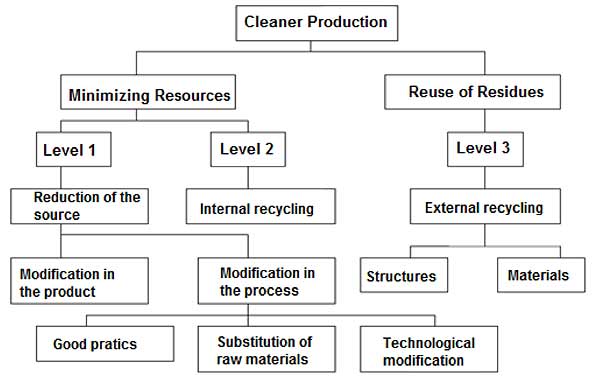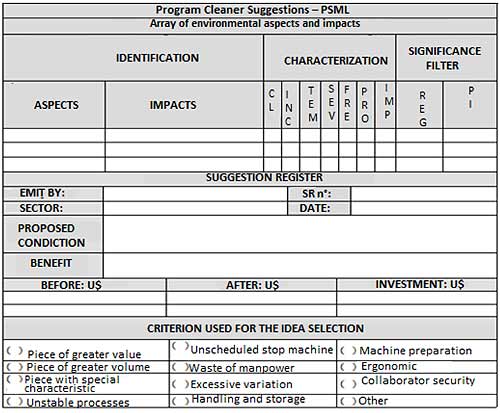4. Results and Discussions
4.1 Cleaner Production
The visits held in the Company Suprametal in May 2010, were divided in three steps. The first step was the observation on the spot of the production process of secondary aluminum. The second step was held with the intuition of raising the environmental impacts and aspects of the process, as presented in the Table 1.
Table 1 – Array of environmental aspects and impacts for decision making
IDENTIFICATION |
CHARACTERIZATION |
SIGNIFICANCE FILTER |
||||||||
Aspects |
Impacts |
C L |
I N C |
T E M |
S E V |
F R E |
P R O |
I M P |
R E G |
I P |
Use of chemical substances |
Soil contamination |
A |
D |
F |
3 |
3 |
2 |
8 |
X |
X |
Use of metals |
Soil contamination and natural resources decrease |
A |
D |
F |
3 |
3 |
3 |
9 |
|
X |
Water and energy consumption |
Natural resources consumption |
A |
I |
A |
2 |
3 |
3 |
8 |
|
X |
Work conditions |
Accident risk |
A |
I |
F |
1 |
1 |
1 |
3 |
|
X |
Equipaments maintenance |
Gas emissions, soil contamination and effluent, fuel consumption (energy) |
A |
D |
A |
3 |
3 |
1 |
7 |
X |
X |
Storage of chemicals |
Soil contamination and effluent |
A |
D |
F |
3 |
3 |
1 |
7 |
X |
X |
Gas emissions |
Atmospheric pollution and air contamination |
A |
D |
A |
3 |
2 |
2 |
7 |
X |
|
Solid waste generation |
Soil and water contamination |
A |
D |
A |
2 |
1 |
2 |
5 |
X |
X |
Gas canister |
Atmospheric pollution and soil contamination |
A |
D |
A |
3 |
2 |
2 |
7 |
|
|
*Source: Authors.
*Array’s label: CL: class (beneficial or adverse); INC: incidence (direct or indirect); TEM: temporality (actual or future); SEV: severity (1=low, 2=medium or 3=high); FRE: frequency (1=rarely, 2=periodically or 3=continuously); PROB: probability (1=remote, 2=probable or 3=very probable); IMP: importance (sum SEV+FRE+PROB); REG: regulation; IP: interested parts, example ONGs, clients or government.
Through of the analysis of the criticality array the authors selected the impacts that are most relevant for the company. For such selection, was used the significance filter, and the impacts that had more markings in this area of the array, or that had presence in all column filter.
Several environmental impacts presented many markings in the significance filter. Although, as priority, the authors selected that with severity of 3, because are these that present higher risk to the employees of the company, environment and still are liable of pens sanctions, for noncompliance of laws and environmental standards.
Furthermore, is evident that is not possible to solve all nonconformities of the company in an only step. Then, the authors suggested that the first taking decision of impacts prevention would be about chemical substances and metals – soil contamination, water and effluents, toxic gases emissions and risk of explosions.
After verified the environmental impacts and aspects, the third step was the identification of the opportunities of minimization of residues generation at the source, through of Cleaner Production, as illustrated the prioritizations of the Figure 3.

Fig. 3. Opportunities of minimizing of residues in the source by the Cleaner Production.
Source: CNTL (2003).
It was identified that the Suprametal Company presents approach in The Cleaner Production in the level 3, by performing external recycling of their refuses (slag).
Considering all levels of Cleaner Production decision can be taken as:
- Level 1: continuous improvement aiming residues reduction;
- Level 2: to search by the internal recycling of the slag and raw materials discarded by the sweeping;
After these previous analysis of the environmental impacts and aspects, and if the company is inside of the standards of the Cleaner Production, was suggested the Implementation of a Suggestions Program, with the objective of launching themes and collecting ideas from employees for the resolution of the problems identified.
4.2 Implementation Proposal of a Suggestion Program
During the search, it was identified and released the environmental aspects as Table 1, being distributed a form, in paper, for the all the employees registered improvement suggestions for the process in question. Table 2 related the problems identified and the best suggestions collected in this step.
Table 2 – Environmental aspects and improvement suggestions
ENVIRONMENTAL ASPECT |
IMPROVEMENT SUGGESTION |
At the weighing moment it doesn’t have absolute certainty of the material |
Use of magnets for ferrous and nonferrous materials detection |
There isn’t classification at the storage |
Screening realization and paper register of the incoming material |
Inappropriate storage of the raw material |
Use of pre-established locals for the storage |
Lack of classification as for the pieces sizes |
Classify and storage the equipment for the raw material in the dimensions for oven insertion |
High noise from the exhaust fan |
Equipment’s replacement |
Gas emission on the process |
Buy equipment that realizes the appropriate treatment and exhaust of the gases |
Ergonomic issues at the activities |
Review and adopt ergonomic improvements for the activities |
50% of the slag consist of aluminum |
Change the slag selector (to add less aluminum to the slag formed) |
Raw material waste on the sweeping |
Sift and realize the screening of the material from the sweeping |
Lack of time determination on the chemical samples |
Label the samples with validity |
Source: Authors.
With the possession of the best ideas, the company waits that with the implementation of suggestions mentioned earlier, to get a significance costs reduction, improving the quality of their products, optimizing its process without damages to the environment.
The proposal of the authors of this article is that the company incorporates the Suggestions Program to the Cleaner Production tool for both identifying the problems and collecting at the same time, the suggestions to solve them.
According with Scherer and Carlomagno (2009, p. 137) an Ideas Program “contributes stimulating an open working environment in which the own employees should improve their processes […] the registration of the ideas is the beginning of the process. It can be induced or spontaneous”.
Still according to the authors (p. 138) “to guarantee the significant participation, is detailing of the idea as it evolves”.
Thus, the Suggestions Program allows leveraging the several tools as the case Cleaner Production for the improvement of the internal environmental processes.
5. Final Considerations
The concern with the environmental questions presents itself of a way more constant in the debates and discussions as fomentation factor to the organizational sustainability. The Environmental Management System offers tools to align the concepts to the Standards and Legal Requirements together with the company need.
The case study performed in this paper allowed to identify for intermediate of the previous diagnosis of Cleaner Production, that the company needs of many improvements in the environmental question, since, presented several environmental aspects and impacts that need to be improved for a better performance of the same.
For such, the idea of Suggestion Program, formal and structured channel of collect of ideas for the employees, is a method that allows the launch of raised by the diagnostic of Cleaner Production in the search of fast, simple solutions and of low costs for the company.
As for example: the utilization of adequate locals for the storage of the raw material, the use of magnet for detecting materials with iron and without iron in the weighing of the materials.
Being thus the proposed model in this article by the authors is a Suggestions Program Cleaner (SPC) that has for methodology to use firstly the Cleaner Production tool, by the previous diagnostic of the aspects and impacts array for the taking decision, together with viability study technique, economic and environmental, for a second time, for the company to launch themes relative to the identified problems with the objective of generating and collecting ideas that solve these problems.
For that, together with the array is created the model for deposit of the suggestions, as shown the Figure 4:

Fig. 4 Model from the Program Cleaner Suggestions.
Source: Authors.
6. References
BARBIERI, J. C. (2004). “Gestão ambiental empresarial:” conceitos, modelos e instrumentos. São Paulo: Saraiva.
BARBIERI, J. C.; ÁLVARES, A. C. T.; CAJAZEIRA, J. (2008). “Geração de Ideias para Inovações:” Estudos de Casos e Novas Abordagens. In: SIMPÓSIO DE ADMINISTRAÇÃO DA PRODUÇÃO, LOGÍSTICA E OPERAÇÕES INTERNACIONAIS, 11., 2008, São Paulo. Anais eletrônicos... São Paulo: SIMPOI.
BARBIERI, J. C.; ÀLVARES, A. C. T.; CAJAZEIRA, J. E. R. (2009). “Gestão de Ideias para Inovação Continua”. Porto Alegre: Bookman.
BÖHMERWALD, P. (1996). “Gerenciando o sistema de sugestões”. Belo Horizonte: Fundação Cristiano Ottoni.
CNTL - Centro Nacional de Tecnologias Limpas (2001). “Manual de questões ambientais e produção mais limpa”. Curso de Formação de Consultores em Produção mais Limpa, Fortaleza, dezembro.
CNTL - Centro Nacional de Tecnologias Limpas (2002). “Manual metodologia de implantação do programa de produção mais limpa”. Curso de Consultores em Produção mais Limpa, Fortaleza, janeiro.
CNTL - Centro Nacional de Tecnologias Limpas (2003). “Curso de Formação de Consultores em Produção mais Limpa para Pequena e Microempresa”. Módulo 1, Porto Alegre: CNTL.
DANIHELKA, P. (2004) Subjective factors of Cleaner Production – parallel to risk perception? “Journal of Cleaner Production”, London, v. 12, 581-584 p.
DINIZ, A. G. F. (2007) “Produção mais Limpa:” uma metodologia para o desenvolvimento sustentável, 2007, 98f. Dissertação (Engenharia de Produção), Universidade Tecnológica Federal do Paraná, Ponta Grossa.
GIL, A. C. (1999). “Métodos e Técnicas de Pesquisa Social”. São Paulo: Atlas.
JAPAN HUMAN RELATIONS ASSOCIATION (1997). “O livro das idéias: o moderno sistema japonês de melhorias e o envolvimento total dos funcionários”. Porto Alegre: Artes Médicas.
LAKATOS, E. M.; MARCONI, M. A. (2000). Metodologia Científica. 3ºed., São Paulo: Atlas.
MOURA, L. A. (2000). “Economia ambiental – gestão de custos e investimentos”. São Paulo: Juarez de Oliveira.
PERRETTI, G. A. et al. (2007) “Vantagens da Implantação da Produção mais Limpa”. In: 1st International Workshop Advances in Cleaner Production, novembre.
PIMENTA, H. C.; GOUVINHAS, R. P. (2007). “Implementação da produção mais limpa na indústria de panificação de Natal – RN”. In: XXVII Encontro Nacional de Engenharia de Produção, Foz do Iguaçu, Paraná, outubro.
PNUMA – Programa das Nações Unidas para o Meio Ambiente (1993). “Cleaner Production for Worldwide”. PNUMA.
SCHERER, F. O.; CARLOMAGNO, M. S. (2009). “Gestão da Inovação na Prática:” como aplicar conceitos e ferramentas para alavancar a inovação. São Paulo: Atlas.
SILVA FILHO, J. C. G.; SICSÚ, A. B. (2003). “Produção mais Limpa:” uma ferramenta da Gestão Ambiental aplicada às empresas nacionais. In: XXIII Encontro Nacional de Engenharia de Produção, Ouro Preto, Minas Gerais, outubro.
SOUZA, A; YONAMINE, J. S. G. (2002). “Os impactos de um programa de sugestão de melhorias para a lucratividade do negócio e motivação dos funcionários:” Um estudo de caso. In: ENCONTRO DE ENGENHARIA DE PRODUÇÃO, 22., 2002, Curitiba. Anais eletrônicos... Rio de Janeiro: ABEPRO.